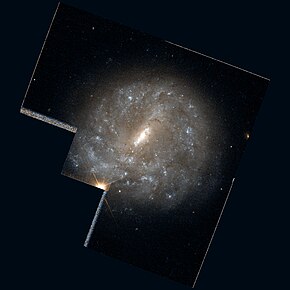NGC 4900 is a barred spiral galaxy in the constellation Virgo. It was discovered by William Herschel on April 30, 1786.[3] It is a member of the NGC 4753 Group of galaxies, which is a member of the Virgo II Groups, a series of galaxies and galaxy clusters strung out from the southern edge of the Virgo Supercluster.[4]
| NGC 4900 | |
|---|---|
 Hubble Space Telescope image of NGC 4900 | |
| Observation data (J2000 epoch) | |
| Constellation | Virgo |
| Right ascension | 13h 00m 39s[1] |
| Declination | +02° 30′ 05″[1] |
| Redshift | 0.003201[2] |
| Heliocentric radial velocity | 960 ± 3 km/s[2] |
| Apparent magnitude (B) | 12.8[1] |
| Characteristics | |
| Type | SB(rs)c;WR HII[2] |
| Other designations | |
| NGC 4900, MCG+01-33-035, UGC 8116, PGC 44797 | |
One supernova has been observed in NGC 4900: SN 1999br (Type II, mag. 17.5).[5]
See also
editReferences
edit- ^ a b c "NGC 4900". SIMBAD. Centre de données astronomiques de Strasbourg. Retrieved 7 June 2019.
- ^ a b c "NASA/IPAC Extragalactic Database". ned.ipac.caltech.edu. Retrieved 7 June 2019.
- ^ Seligman, Courtney. "New General Catalog Objects: NGC 4900 - 4949". New General Catalog Objects: NGC 4900 - 4949. Retrieved 7 June 2019.
- ^ "The Virgo III Groups". Atlas of the Universe. Retrieved 2010-11-27.
- ^ Transient Name Server entry for SN 1999br. Retrieved 22 March 2023.
External links
edit- Media related to NGC 4900 at Wikimedia Commons
- NGC 4900 on WikiSky: DSS2, SDSS, GALEX, IRAS, Hydrogen α, X-Ray, Astrophoto, Sky Map, Articles and images